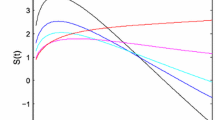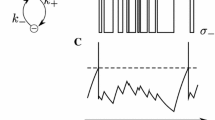Abstract
Simulated neural impulse trains were generated by a digital realization of the integrate-and-fire model. The variability in these impulse trains had as its origin a random noise of specified distribution. Three different distributions were used: the normal (Gaussian) distribution (no skew, normokurtic), a first-order gamma distribution (positive skew, leptokurtic), and a uniform distribution (no skew, platykurtic). Despite these differences in the distribution of the variability, the distributions of the intervals between impulses were nearly indistinguishable. These inter-impulse distributions were better fit with a hyperbolic gamma distribution than a hyperbolic normal distribution, although one might expect a better approximation for normally distributed inverse intervals. Consideration of why the inter-impulse distribution is independent of the distribution of the causative noise suggests two putative interval distributions that do not depend on the assumed noise distribution: the log normal distribution, which is predicated on the assumption that long intervals occur with the joint probability of small input values, and the random walk equation, which is the diffusion equation applied to a random walk model of the impulse generating process. Either of these equations provides a more satisfactory fit to the simulated impulse trains than the hyperbolic normal or hyperbolic gamma distributions. These equations also provide better fits to impulse trains derived from the maintained discharges of ganglion cells in the retinae of cats or goldfish. It is noted that both equations are free from the constraint that the coefficient of variation (CV) have a maximum of unity. The concluding discussion argues against the random walk equation because it embodies a constraint that is not valid, and because it implies specific parameters that may be spurious.
Similar content being viewed by others
References
Berger D, Pribram K, Wild H, Bridges C (1990) An analysis of neural spike-train distributions: determinants of the response of visual cortex neurons to changes in orientation and spatial frequency. Exp Brain Res 80:129–134
Cleland BG, Lee BB (1985) A comparison of visual responses of cat lateral geniculate nucleus neurones with those of ganglion cells afferent to them. J Physiol (Lond) 369:249–268
Frishman LJ, Levine MW (1983) Statistics of the maintained discharge of cat retinal ganglion cells. J Physiol (Lond) 339:475–494
Gerstein GL, Mandelbrot B (1964) Random walk models for the spike activity of a single neuron. Biophys J 4:41–68
Gestri G, Mastebroek HAK, Zaagman WH (1980) Stochastic constancy variability and adaptation of spike generation: performance of a giant neuron in the visual system of the fly. Biol Cybern 38:31–40
Goldberg JM, Smith CE, Fernández C (1984) Relation between discharge regularity and response to externally applied galvanic currents in vestibular nerve afferents in the squirrel monkey. J Neurophysiol 51:1236–1256
Hanson FB, Tuckwell HC (1983) Diffusion approximations for neuronal activity including synaptic reversal potentials. J Theor Neurobiol 2:127–153
Johannesma PIM (1968) Diffusion models for the stochastic activity of neurons. In: Caianiello ER (ed) Neural networks. Springer, Berlin Heidelberg New York, pp 116–144
Knight BW (1972) Dynamics of encoding in a population of neurons. J Gen Physiol 59:734–766
Kuffler SW, FitzHugh R, Barlow HB (1957) Maintained activity in the cat's retina in light and darkness. J Gen Physiol 40:683–702
Levine MW (1982) Retinal processing of intrinsic and extrinsic noise. J Neurophysiol 48:992–1010
Levine MW (1987) Variability in the maintained discharges of retinal ganglion cells. JOSA A 4:2308–2320
Levine MW, Shefner JM (1977a) The effects of photic stimulation upon the variability of the interspike intervals in goldfish ganglion cells. Vision Res 17:793–797
Levine MW, Shefner JM (1977b) A model for the variability of interspike intervals during sustained firing of a retinal neuron. Biophys J 19:241–252
Levine MW, Saleh EJ, Yarnold P (1988) Statistical properties of the maintained discharge of chemically isolated ganglion cells in goldfish retina. Vis Neurosci 1:31–46
Montroll EW, Shlesinger MF (1982) On 1/f noise and other distributions with long tails. PNAS 79:3380–3383
Pernier J (1972) Ajustement automatique des densités de probabilité d'intervalles entre potentiels d'action selon la loi de Wiener. Biometrics 28:737–745
Pernier J, Gerin P (1975) Temporal pattern analysis of spontaneous unit activity in the neocortex. Biol Cybern 18:123–136
Rodieck RW (1967) Maintained activity of cat retinal ganglion cells. J Neurophysiol 30:1043–1071
Schwartz M, Shaw L (1975) Signal processing. McGraw-Hill, New York, pp 104–109
Shefner JM and Levine MW (1979) A comparison of properties of goldfish retinal ganglion cells as a function of lighting conditions during dissection. Vision Res 19:83–89
Smith CE (1979) A comment on a retinal neuron model. Biophys J 25:385–386
Stein RB (1965) A theoretical analysis of neuronal variability. Biophys J 5:173–194
Ten Hoopen M (1966) Probabilistic firing of neurons considered as a first passage problem. Biophys J 6:435–451
Author information
Authors and Affiliations
Rights and permissions
About this article
Cite this article
Levine, M.W. The distribution of the intervals between neural impulses in the maintained discharges of retinal ganglion cells. Biol. Cybern. 65, 459–467 (1991). https://doi.org/10.1007/BF00204659
Received:
Accepted:
Issue Date:
DOI: https://doi.org/10.1007/BF00204659




